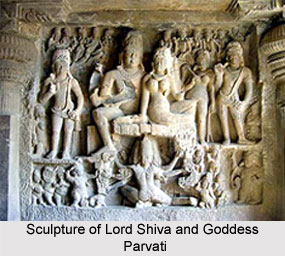 Ellora Kailasanathar temple is covered fully with exquisite sculptures. This temple is the world`s largest monolithic structure. The great block of residual rock was carved into the three- storeyed vimana, the main mandapa, two giant dhwajasthambas and four sub- shrines.
Ellora Kailasanathar temple is covered fully with exquisite sculptures. This temple is the world`s largest monolithic structure. The great block of residual rock was carved into the three- storeyed vimana, the main mandapa, two giant dhwajasthambas and four sub- shrines.
With starting from the top, the mass of rock was given the particular shape. And as the layer was shaped to its proposed shape, the sculptors began ornamenting the structure. Hence, before moving downward, each layer was hewn and decorated completely, that helped in eliminating the need for any scaffolding. The main shrine and the Nandi mandapa are built on a plinth, at a higher level ranging over 7.8 metres. On the entire vertical surface of this is carved with mythical animals and gargoyles.
The Main Temple is seen as flanked on either side of the two free- standing pillars of some 15.9 meters in height. The gracefully proportioned pillars attract the attention & believed to have once borne for the trishul or trident of Shiva. Corridors have been carved into the mountain that ranges the temple on three sides. These corridors contain a series of sculpted figures depicting the scenes from the great Hindu epics, the Mahabharata and the Ramayana. The temple is flanked by huge elephants all carved from solid rock, pillars and podiums. The walls have pilasters and niches. Niches contain narrative sculptures. The sculptural decoration of the temple is not crowded. Along the base there are bands of sculptures relating stories from the epics. For example Goddess Durga fighting with Mahisha, the Demon Buffalo and Ravana shaking Kailasa have been sculpted.
Chota Kailasa Temple: More 2 kms along the same rock-face are the Jain caves. Among these the Chota Kailasa in cave 30 and the Indrasabha in Cave 32 are noteworthy. Chhota Kailasa is a miniaturized version of the Hindu Kailasa temple. And the masterpiece of the Jain caves can be represented through the Indrasabha temple. The doorway opens in a courtyard where a small shrine was placed. It is flanked by a huge dhwajsthamba and a statue of an elephant. The three-sides of the temple wall are carved in a series of shrines to the many Jain tirthankaras.



















